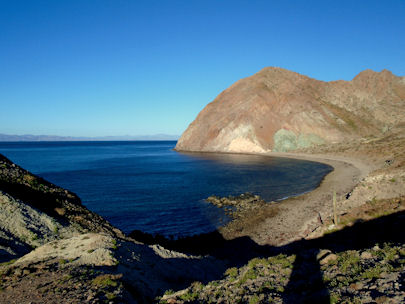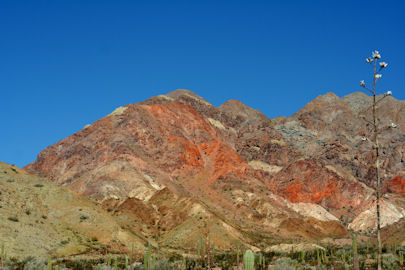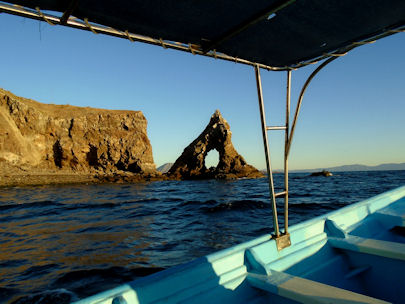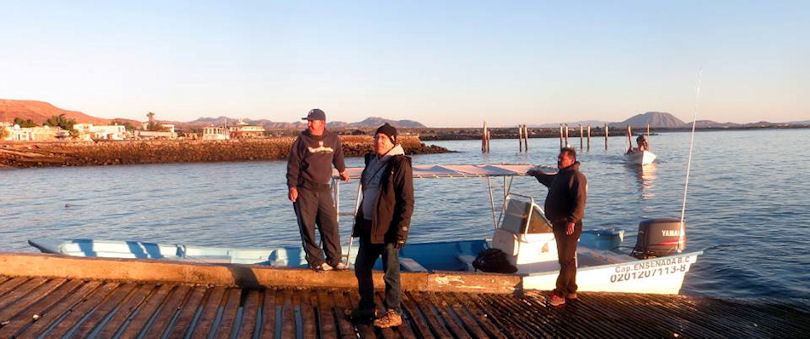 |  |
by Peter Breslin

The second largest island in the Sea of Cortez stretches out almost along the entire horizon as we crest the last hill along the side road to Bahía de Los Angeles. Isla Angel de la Guarda does not look exactly inviting far out in the blue water, its fierce crags and striated, multicolored cliffs visible even from miles away. It looks, in fact, more like a continent on Mars than a Gulf island. Yet the excitement of the pending visit to its shores is undeniable.
I have been traveling to Bahía de Los Angeles for 22 years and had not once made a trip out on the water of the bay, not even to the very nearest of the islands. As a botanist, my concerns have been focused more on the peninsula itself. Botanical research on the peninsula has not left much time for sport fishing, wind surfing, whale watching, swimming with whale sharks, kayaking or any of the other activities that draw most Bahía de Los Angeles visitors from the shore out into the waters.
But this visit, finally, a botanical expedition to Angel de la Guarda was in the works, in particular to find, study and photograph the rare, endemic yellow barrel cactus, or as the locals call it, biznaga amarillo. Well known from a population on the eastern side of the island, first described as a new species in 1923, this barrel cactus draws "plant tourists" from around the world. Our expert boat captain, Ricardo Arce Navarro, about whom more later, mentioned having taken Japanese, Czech, German, Italian, American and British plant cactus aficionados out to Isla Angel in the past few years for the sole purpose of seeing this plant.
A comfortable and friendly way to get ready for an excursion into the bay, either to one or more of the closer islands or all the way out to the “big island,” is to camp in the spacious palapas at well known Campo Archelon, run by Antonio and Bety Resendiz.  This campo ecologico features hot showers and a spectacular view of the bay and islands and is only $8 US per person per night. Look for signs along the road north to La Gringa, not too far from town. Antonio is an excellent guide to outdoor activities with an ecological focus and he has extensive knowledge of the flora and fauna of the area. His marine turtle rescue and conservation efforts, which began in the 1970s, have led to a nearly complete recovery of several marine turtle species in the bay.
This campo ecologico features hot showers and a spectacular view of the bay and islands and is only $8 US per person per night. Look for signs along the road north to La Gringa, not too far from town. Antonio is an excellent guide to outdoor activities with an ecological focus and he has extensive knowledge of the flora and fauna of the area. His marine turtle rescue and conservation efforts, which began in the 1970s, have led to a nearly complete recovery of several marine turtle species in the bay.
It was through Antonio’s recommendation that we obtained the boat charter with Ricardo Arce Navarro. Ricardo’s main specialty is scuba diving tours, as one can tell from his website. The trip to Isla Angel de la Guarda was reasonably priced at $350 US. It is a long journey, even to the western side of the island. We huddled with Antonio and Ricardo the night before our scheduled trip to look at weather forecasts for the bay and come up with a plan.
Our travel schedule necessitated a winter trip to the bay on this visit. In winter, the bay is known for fierce north winds that kick in just after noon, nearly every day. These north winds drive high seas in the center of the bay, between the inner islands and Isla Angel de la Guarda, the famed "Canal de las Ballenas." Our window for the trip was narrow, and within that window, the available days all showed the probability of strong afternoon winds. An excellent source for weather information and wind patterns for the bay, used by kayakers, wind surfers and fishing boat captains regularly, is Wind Finder. There would be no possibility of a trip all the way to the eastern side of the island, since that journey involves a southerly return in the afternoon and the danger of large swells pushing water onto the boat from the stern. We settled on a shorter trip to the western side of the island, to a small bay and beach at Arroyo Este Ton, where expert botanist Reid Moran had recorded a population of the biznaga amarillo in April of 1960.

The departure from Bahía de los Angeles’ new public dock at dawn was uneventful and the ride to the island on calm seas only took about an hour. We embarked from the boat and began hiking the very rugged terrain of Isla Angel, exploring for barrel cacti. However, after several hours, we were unable to find any of the famed barrels on the western side of the island. It was still a wonderful morning of hiking and exploring, with spectacular views and inspiring desert scenery. There are no marked trails and Arroyo Este Ton features a very steep elevation gain over a short distance, so be prepared for somewhat strenuous hiking in the area. The small bay and beach area near Arroyo Este Ton would make an excellent campsite for an extended stay.
Our return journey to Bahía de Los Angeles started at about 1:30 pm, well after the winds had already begun their daily onslaught. Seas were rough crossing back over the Canal de las Ballenas, with 6 foot swells. We were getting soaked to the skin as Captain Ricardo expertly guided the 22 foot Boston Whaler style boat back to calmer waters inside the near islands of the bay. We had hoped to make a stop at the picturesque Isla Ventana on the way back, but were all too chilly and soaked after the return trip, which took nearly 2 hours.
Peeling off our bay-soaked clothing and warming in the winter sun, we happily made our way into town. Alejandrina’s Restaurant awaited for home cooked burritos, bistek ranchero and pescado al mojo de ajo. A quick stop to get some firewood at Xitlali Market, then to Supermercado Liseth for emails and phone calls to loved ones back home, then back to camp to watch the moon rise over the now placid waters of the bay. In the far distance, even in moonlight, the outlines of Isla Angel de la Guarda beckoned for another adventure, another Baja campfire story.

Article contacts:
Campo Archelon - Antonio and Bety Resendiz - resendizshidalgo(at)yahoo.com
Ricardo’s Diving Tours - Ricardo Arce Navarro - ricardoarcen(at)hotmail.com or through his Facebook page
About Peter
Peter Breslin has traveled the length of the Baja California peninsula by car 10 times in the past 4 years and more than 20 times in the past decade, attempting to locate, study and photograph as many of the cacti of that botanically rich area as possible. Along the way, he enjoys camping at remote, undeveloped beaches, eating unforgettable Baja seafood, visiting the islands and hiking the central mountains. He has been published in Cactus & Co., Kakteen und Andere Sukkulenten and The Cactus and Succulent Journal. He began study toward a Ph.D. in Environmental and Life Sciences at Arizona State University in fall of 2014. Travel and research for this trip was made possible through the generous support of the Cactus and Succulent Society of America's research grant program.

Team were on point, provided inside information, prices were great and they had my proposal already...

fast replies and great price!